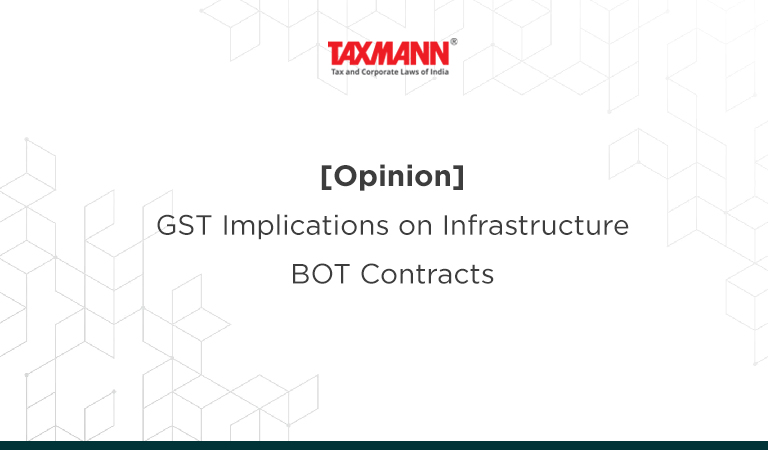[Opinion] GST Implications on Infrastructure BOT Contracts
- Blog|News|GST & Customs|
- 2 Min Read
- By Taxmann
- |
- Last Updated on 1 February, 2023
The transportation sector is an indispensable part of an economy such that a hitch could lead to standstill the economy. The Prime Minister’s recent announcements which are intended to stream-line multi-modal transport, emphasizes the importance of this sector.
India has the second largest road network and fourth largest railway network in the world. Maritime transport consists of around 95 percent of India’s trading by volume and 70 percent by value.
Owing to such crucial placement of transport sector in the functioning of our economy the Government has taken initiatives such as increase in Public-Private Partnership (PPP) models in roadways, railways infrastructure projects (‘Infrastructure’). Such PPP projects are based on the Build -Operate-Transfer (BOT) model where the private partner (referred to as ‘Concessionaire’) is contracted to build, operate and eventually, transfer the ownership of the infrastructure project.
A variant of the BOT model that is generally used in Design-Build-Finance-Operate-Transfer (DBFOT) where in addition to the functions mentioned in BOT the Concessionaire is required to design the project and either partially or completely finance the project.
BOT projects
Generally, a BOT projects have 3 key stages
1. Build – The Concessionaire designs and constructs the infrastructure. Generally, there is no payment made by the Government during this stage.
2. Operate – On completion of construction, the Concessionaire is provided rights to operate and maintain the infrastructure. Consideration is received by the Concessionaire either through collection of charges from the public for using the infrastructure or receipt of annuity from the Government. The period of this stage may vary from 20 to 30 years.
3. Transfer – After the operation period, the ownership and maintenance of the infrastructure is transferred to the Government.
Depending on the manner of disbursement of consideration to the Concessionaire, BOT projects may be further classified as follows:
- BOT – Toll Model
- BOT – Annuity Model
- BOT – Hybrid Annuity Model
Click Here To Read The Full Article
Disclaimer: The content/information published on the website is only for general information of the user and shall not be construed as legal advice. While the Taxmann has exercised reasonable efforts to ensure the veracity of information/content published, Taxmann shall be under no liability in any manner whatsoever for incorrect information, if any.

Taxmann Publications has a dedicated in-house Research & Editorial Team. This team consists of a team of Chartered Accountants, Company Secretaries, and Lawyers. This team works under the guidance and supervision of editor-in-chief Mr Rakesh Bhargava.
The Research and Editorial Team is responsible for developing reliable and accurate content for the readers. The team follows the six-sigma approach to achieve the benchmark of zero error in its publications and research platforms. The team ensures that the following publication guidelines are thoroughly followed while developing the content:
- The statutory material is obtained only from the authorized and reliable sources
- All the latest developments in the judicial and legislative fields are covered
- Prepare the analytical write-ups on current, controversial, and important issues to help the readers to understand the concept and its implications
- Every content published by Taxmann is complete, accurate and lucid
- All evidence-based statements are supported with proper reference to Section, Circular No., Notification No. or citations
- The golden rules of grammar, style and consistency are thoroughly followed
- Font and size that’s easy to read and remain consistent across all imprint and digital publications are applied








 CA | CS | CMA
CA | CS | CMA


